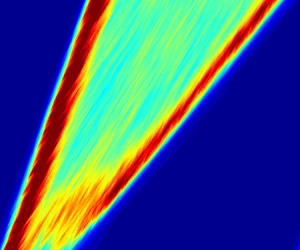Article contents
Scaling and mechanism of the propagation speed of the upstream turbulent front in pipe flow
Published online by Cambridge University Press: 21 December 2023
Abstract

The scaling and mechanism of the propagation speed of turbulent fronts in pipe flow with the Reynolds number has been a long-standing problem in the past decades. Here, we derive an explicit scaling law for the upstream front speed, which approaches a power-law scaling at high Reynolds numbers, and we explain the underlying mechanism. Our data show that the average wall distance of low-speed streaks at the tip of the upstream front, where transition occurs, appears to be constant in local wall units in the wide bulk-Reynolds-number range investigated, between 5000 and 60 000. By further assuming that the axial propagation of velocity fluctuations at the front tip, resulting from streak instabilities, is dominated by the advection of the local mean flow, the front speed can be derived as an explicit function of the Reynolds number. The derived formula agrees well with the speed measured by front tracking. Our finding reveals a relationship between the structure and speed of a front, which enables a close approximation to be obtained of the front speed based on a single velocity field without having to track the front over time.
- Type
- JFM Rapids
- Information
- Copyright
- © The Author(s), 2023. Published by Cambridge University Press
References
Wu and Song supplementary movie
- 1
- Cited by



